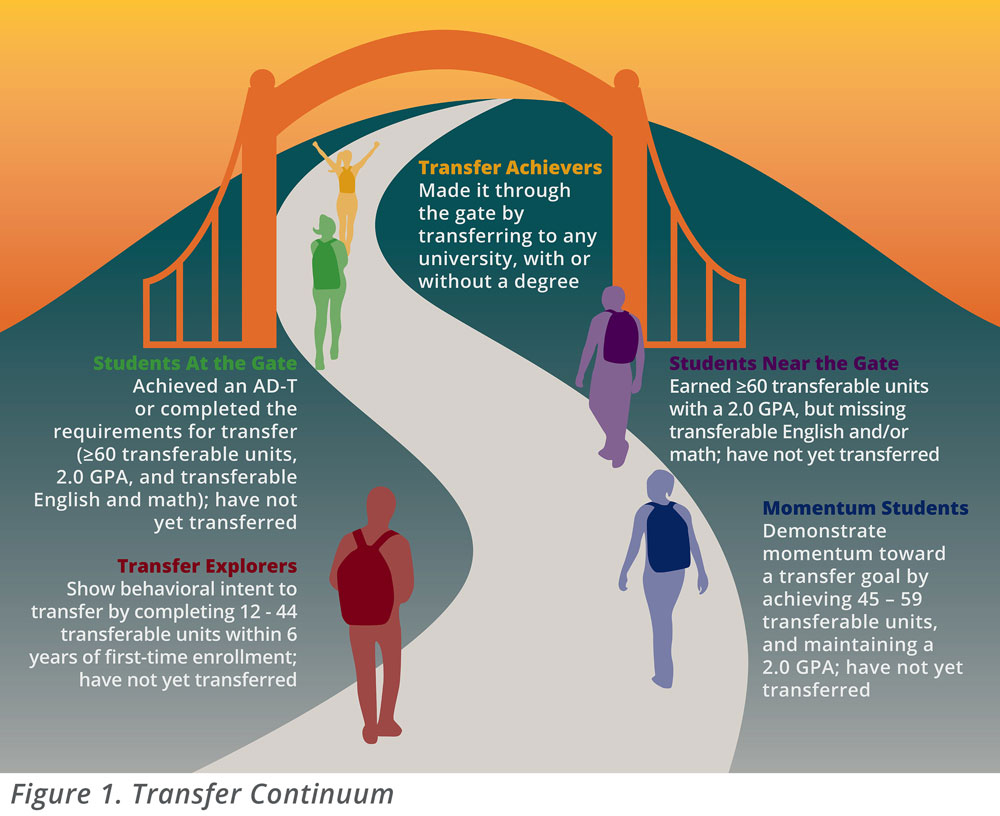Overview
This RP Group effort focuses on identifying ways to increase transfer for a “high-leverage” group of community college students: those who are close to transfer but have not yet made it to university.
A Fresh Take on Community College Transfer
Transfer is a journey that a varied group of students undertake. In 2016, the RP Group began taking a more nuanced look at this  population through our inaugural Through the Gate transfer study – establishing a “transfer continuum” to recognize that students at different points along the transfer path may have various experiences, obstacles, and needs (Figure 1).
population through our inaugural Through the Gate transfer study – establishing a “transfer continuum” to recognize that students at different points along the transfer path may have various experiences, obstacles, and needs (Figure 1).
A Lost Opportunity for California
We also found that each year, nearly 60,000 California community college students who demonstrate the determination and academic ability to transfer do not make it to university. Who’s most likely to get stuck? Students from historically marginalized by our higher education systems.
Given that the state has embraced transfer as a key mechanism for preparing a diverse and qualified workforce while simultaneously closing equity gaps and promoting economic mobility for its residents, these students comprise a “high-leverage” group on which to focus efforts to improve equitable transfer outcomes.
Our Commitment
The RP Group launched Through the Gate in 2016 with generous support from College Futures Foundation. Additional projects – including our African American Transfer Tipping Point Study and our examination of COVID-19’s impact on students’ transfer experience – are expanding on this initial research to further elevate the experiences of this important population and shed light on opportunities for bettering their results.
Who is transferring, who is not, and for what reasons? What can be done to facilitate this transition for significantly more students? We are exploring these questions through this multi-year project:
-
Phase 1: Mapping the Transfer Landscape (2016 – 2018)
Quantitative research to understand the transfer landscape, determining: (1) how many students in California arrived at the transfer gate, but did not go through, and (2) who they are and where they reside.
-
Phase 2: Getting Better Directions (2019)
Quantitative and qualitative research with students who are close to transfer to understand what factors impact their journey and how policy and practice might change to propel them through the transfer gate.
-
Phase 3: Engaging for Action (2020)
Convenings with CCC, CSU, and UC leaders, educators, researchers, and advocacy groups to identify strategic opportunities to strengthen transfer success based on findings.
_______________________________________
-
Johnson, H., Cook, K., & Mejia, M. C. (2017). Meeting California’s need for college graduates. San Francisco, CA: Public Policy Institute of California. Retrieved from http://www.ppic.org/content/pubs/report/r_0617hjr.pdf
-
California Community Colleges Chancellor’s Office. (2017). California Community Colleges Vision for Success. Retrieved from http://californiacommunitycolleges.cccco.edu/portals/0/reports/vision-for-success.pdf
-
California Community Colleges Chancellor’s Office Management Information Systems Data Mart. (n.d.). Transfer volume to in-state private and out-of-state baccalaureate granting institutions report. Retrieved from http://datamart.cccco.edu/Outcomes/Student_Transfer_Volume.aspx